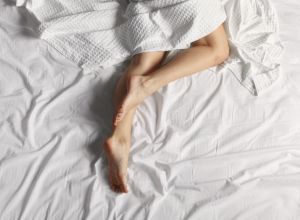
Restless Legs Syndrome (RLS
Restless Legs Syndrome, also called RLS and Willis-Ekbom Disease, is a neurological disorder characterized by unpleasant sensations in the feet and legs along with an uncontrollable urge to move the legs. Because it often interrupts sleep, RLS is also known as a sleep disorder.
Restless Legs Syndrome Symptoms
The number one symptom of RLS is an irresistible urge to move one’s legs, especially during periods of rest and while sleeping. The need to move may be accompanied by unpleasant and uncomfortable feelings in the legs that patients describe as burning, tugging, itching, creeping, pins and needles and/or like insects are crawling around inside the legs. The sensations range from mild to absolutely unbearable.
Though most cases of RLS affect solely the legs, some people experience symptoms in other parts of the body, including the arms and torso.
Because symptoms of Restless Legs Syndrome affect a person’s sleeping habits, the condition often leads to anxiety, depression, exhaustion, heart attacks, stroke and a poor quality of life.
Restless Legs Syndrome Causes
About 10% of the US population develops RLS. There’s no hard and fast reason why some people develop the condition and other do not. However, RLS is most frequently diagnosed in middle-aged individuals — though, it can affect people of all ages, even children.
RLS is hereditary in about 50% of cases, which doctors refer to as primary RLS. In the other 50% of cases, RLS usually develops as a result of another condition, which doctors call secondary RLS.
Some things can cause secondary RLS or increase symptoms of the condition include:
- Chronic diseases like diabetes, iron deficiency, kidney failure, Parkinson’s disease and peripheral neuropathy
- Certain medications, including antidepressants, antinausea drugs, antipsychotic drugs, and cold and allergy medicines that contain antihistamines
- Pregnancy, which can cause some women to experience a temporary form of the condition in the last trimester
- Alcohol and nicotine use
- Sleep deprivation
RLS Treatment
There is currently no cure for Restless Legs Syndrome, nor is there a test to determine if a person has the condition. However, there are several treatment options that help decrease the severity and frequency of symptoms.
For people with mild RLS, doctors usually suggest simple lifestyle changes that can help decrease symptoms. These steps include exercising regularly, eliminating alcohol, nicotine and caffeine intake, establishing a regular sleeping pattern and engaging in light foot and leg stretches. Other treatments may include foot and leg massages, warm baths and drug-free relaxing devices like Relaxis or Restiffic.
READ MORE: Foot Wrap Replaces Medication For Restless Legs Syndrome (RLS) Treatment
For more severe cases of RLS, doctors may prescribe medication that helps relieve symptoms. These drugs include dopaminergic drugs that act on the neurotransmitter dopamine in the brain (which experts believe may be responsible for RLS), benzodiazepine to help induce sleep, narcotic pain relievers and antiseizure/anticonvulsant drugs.
Some people respond to RLS drug therapy, but many people actually experience worse symptoms when using medication for RLS. Furthermore, many of the drugs work at first but lose their effectiveness over time and/or augment, meaning they work at first but then cause symptoms to occur during other parts of the day and possibly spread to other parts of the body.
Notice concerning medical entries:
Articles having medical content shall serve exclusively for the purpose of general information. Such articles are not suitable for any (self-) diagnosis and treatment of individual illnesses and medical indications. In particular, they cannot substitute for the examination, advice, or treatment by a licensed physician or pharmacist. No replies to any individual questions shall be effected through the articles.







